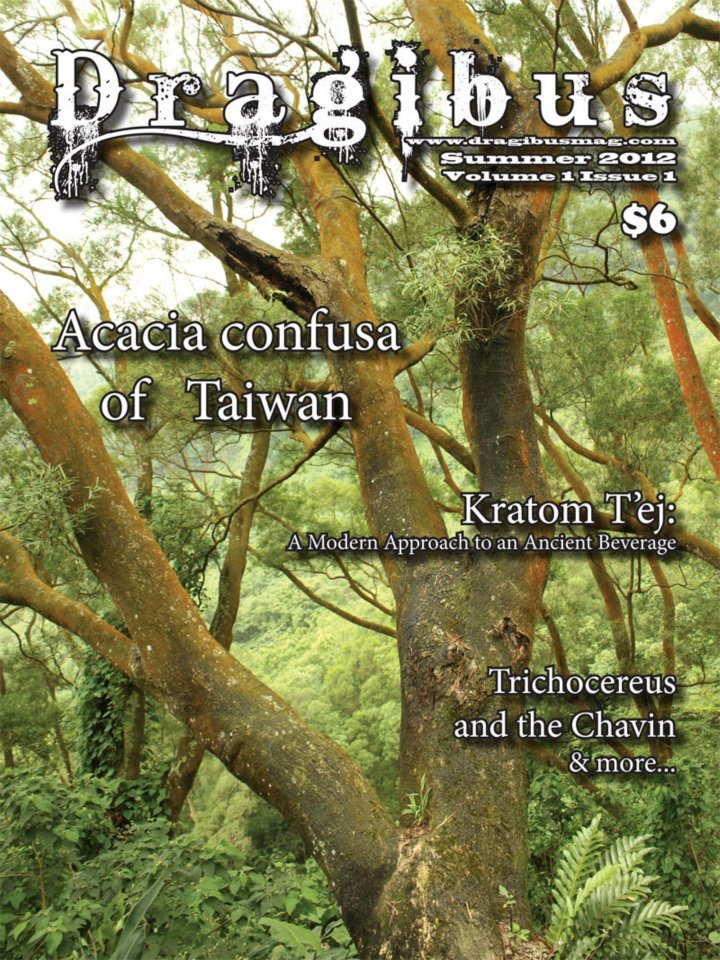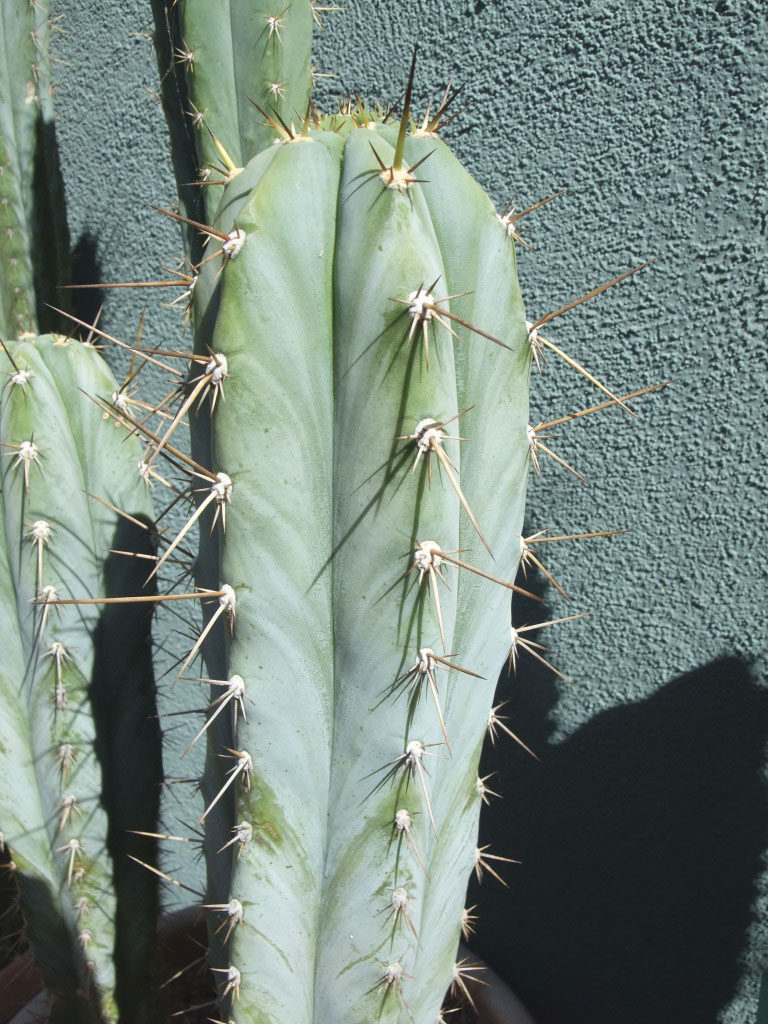Trichocereus and the Chavin: A love story
From Dragibus Magazine Volume 1 Issue 1
By Donnie Cryder
To say that the people of Peru have an intimate relationship with the San Pedro cactus would be unjust. Love spewed out of the green flesh and into the veins of their ancestors, exploding into a ray of light that opens even modern day consciousness. Tune in my friends because there is a story here to be told. A story of such magnitude, that 3000 years have not changed much of its story.
The term San Pedro comes from Saint Peter and is said to have been the key holder to the gates of heaven. This visionary teacher opens the doors of perception and allows us to enter the Spirit world; thus, allowing communication with the divine. In traditional folk healing, those who drink San Pedro’s nectar open the flood gates to discover divinity and find purpose. The Huachuma or San Pedro (Trichocereus pachanoi, T. peruvianus and T. bridgesii), the sacred cactus and the visionary teacher plant of the South Americas, is especially associated with the shamans and curanderos of the Peruvian Andes.
When European settlers first landed in this portion of the Americas, they brought with them Christianity. This event dramatically changed the indigenous cultures. European Christianity literally invaded the original region where the use of San Pedro indigenously evolved. One could only imagine what they would have thought; witnessing natives’ use of psychoactive plants and particularly, cutting up cactus and drinking the internal goodness. In perspective, couple the use of psychoactive plants with the ceremonial partaking and a negative picture is naturally painted.
A Spanish missionary , as cited by Christian Rätsch, gave the following account:
“It is a plant with whose aid the devil is able to strengthen the Indians in their idolatry; those who drink its juice lose their senses and are as if dead; they are almost carried away by the drink and dream a thousand unusual things and believe that they are true. The juice is good against burning of the kidneys and, in small amounts, is also good against high fever, hepatitis, and burning in the bladder.”
For thousands of years, natives from all over the continent have accepted the journey to the great temple of Chavin de Huantar (modern day Ancash) located in the northern highlands of Peru. Chavin de Huantar is a four to five hour journey from Huaraz and is an archaeological site of the Chavin culture. Furthermore, this site is located on a steep slope of the Andes Mountains of Peru; occupied from about 900-200 B.C. Small stones between large blocks were used to create an extremely strong structure. The plaza has survived 3000 years of earthquakes and has increased in strength over time. With each quake, a small stone shifts to an unyielding position. Chavin de Huantar was first described by a Spanish chronicler in 1521.
Chavin is an early (750-400 BC) ceremonial site at the meeting point of three passes. The plaza is perfectly circular and 20 meters in diameter. In Addition, its rivers drain into the Maranon River and then on to the Amazon. The Old Temple was built during the late Initial Period and was the “center of supernatural power and authority.” For instance, the Old Temple had a sunken platform in a U-shape opening to the east as well as a circular courtyard in the center. The Old Temple also consisted of numerous passageways and underground chambers called galleries. These galleries were used for storage chambers, religious rites, and possibly temporary or permanent living for small groups working with temple activities. The Lanzon Gallery is located at the center of the Old Temple. This was where the sculpture of the Lanzon was discovered but since moved. The Lanzon, the supreme deity of Chavin de Huantar, is anthropomorphic. With its feline head and human body, it has intertwined the feline deity of Chavin de Huantar and the shaman of the pre-Chavin period.
Dating back to 1500 B.C., the earliest known depiction of Huachuma is from the circular plaza of the Old Temple at Chavin de Huantar in the northern highlands of Peru. The site and others of the Chavin culture were investigated by Julio C. Tello between 1919 and 1941; more recent investigations include Luis Lumbreras and Richard Burger. As a result, many artifacts have been discovered on the hills. Stone sculptures are scattered along the site; usually carved out of white granite and black limestone. In addition to the stone sculptures, carved stone mortars and pestles, conch-shell trumpets, bone tubes and spatulas, and metal spatulas and spoons have been discovered decorated in Chavin style. Peruvian ceramics made between 1000 and 700 B.C. depict the plant in association with deer. Similarly, another image includes an owl-faced woman holding a cactus. This comes from a ceramic pot from the Chimu culture, dating back to 1200 A.D. According to native beliefs, the owl is a tutelary spirit and guardian of herbalists and shamans; therefore, the owl-faced woman depicted is most likely a curandera (healer) and huachumera. Another fascinating discovery, by Peruvian archaeologist Rosa Fung, includes a pile of ancient refuse at the Chavin site of Las Aldas near Casma. Namely, the pile of ancient matter seems to contain remnants of cigars made from the cactus. The remnants contribute insight into other uses of the Trichocereus cacti. Nevertheless, modern day shamans are only known to use the plant as a liquid brew that is prepared and saved in jars.
Mescaline, 3,4,5-trimethoxyphenethylamine, is the active compound responsible for the effects of the San Pedro’s hallucinogenic brew. Mescaline is unique among drugs. This is because the main action is a stimulant of the visual and visuo-psychic areas of the cortex. Mescaline is found concentrated in the green outer flesh of the cactus with up to thirty other alkaloids. While unaware of the scientific aspects of mescaline at the time, curanderos knew of this spiritual significance. To the Chavin people, the green flesh of the cactus was a powerful medicine and psychological healer; hence, grounding them to the heaven and earth and interconnecting their souls with the gods. Additionally, shamans acquired power and authority by claiming they walked in the footprints of the divine. The curandero seeks to perceive unity in the dynamic interaction between the forces of good and evil. They do this through their visions. Shaman achieved a high social status somewhat like that of a preacher/president hybrid. This status was effectively used in the preservation of the sacred cactus. However, the plants vigorous growth and climate aids in modern day availability. The use of Achuma is believed to have been related to the phases of the Moon. In general, nocturnal ceremonies take place during Full Moon nights. On the other hand, there is evidence to suggest more broad use patterns. The ritualistic use traditionally started with the ingestion of a hallucinogenic liquid extracted from the San Pedro cactus by the shaman and his patients. The Chavin people would have gulped down the concoction somewhere outside of the oracular centers sacred site of the old temple. Afterwards, they would have been led to a tunnel passage to start a journey into the temple.
No account of an ancient experience has survived time, but from modern day accounts and artifacts discovered; one can paint a picture. Here is my pseudo-experience:
Vision blurred by lack of light, yet cataclysmic fireworks paint a mural of colors on your internal canvas. Walking the corridor you are calm and peaceful. With only Huachuma to guide, your equilibrium is in perfect balance despite the terrain. Spiritual forces of this world (puma), the underworld (snake and lizard), and the heavens (eagle) enter your body. Tranquility sweeps itself under your feet and wraps around your being. All of your worldly thoughts leave you at the entry. Further down the cramped tunnel you hear the beautifully piercing sounds of a strombus conch shell trumpet that made its way to your land. The visions gain power over you and enlighten creativity. Thoughts of serenity and divinity overtake your soul. You are hearing the gods speak! The gentle roar of water canals beneath your feet echo from stone to stone adding a soundtrack to your conversation with the spirits. Further down you go. Hands running along the rough stone you feel a rugged carving of a fanged feline holding in his hand the stalk of a four ribbed San Pedro cactus. Spiraling light explodes of out the openings of each finger into your eyes leaving a silhouette of the anthropomorphic being. Your body fills with calmness and love of life oozes out of your dry pours. Suddenly a flash of light distracts out of the darkness. Pace by pace you follow the sparks down deeper and deeper into your consciousness. Dark shadows move back and forth whispering secrets of the divine as chants of the old shaman dance around your mind. Closer you make it to the gigantic white granite carving appearing to reach the skies. The brightness of the moon shines upon it like was God itself. This is the great Tello Obelisk. Covered in etchings of plants and animals sacred to your tribe she speaks to you. To read it would be impossible without the power and clarity that the San Pedro medicine has given you. Gazing upon this massive structure you see your story added to the stone. Does it fall worthy of the caving? Self-realization and adaption is the key. As the mind spins a theory about universe and time, a tranquil peace hovers above you once again. Kneeling before the stone all sound ceases, water stops flowing and the conch trumpets halt. All that remains are you and the Gods you seek answers from. Departing the dark temple you emerge disoriented yet in sequence with mother earth. A fellow tribesman greets you with open arms then directs you to the Shaman for final words. “Take what you have learned from the medicine and use it to correct your wrong doings.” “Provide for your people and obey your Gods.” “This cleansing of your soul should be a reincarnation for you my son.”
One cannot say what the actual experience would have been like for the Chavin, but a truth is evident. The Chavin used their valuable time and resources to enshrine the Trichocereus cactus for a reason. I challenge all readers to make a pilgrimage to the sacred temple. Read an old love story between a people and a plant carved in stone.
 Order this issue of Dragibus:
Order this issue of Dragibus:
International ($11.50):


